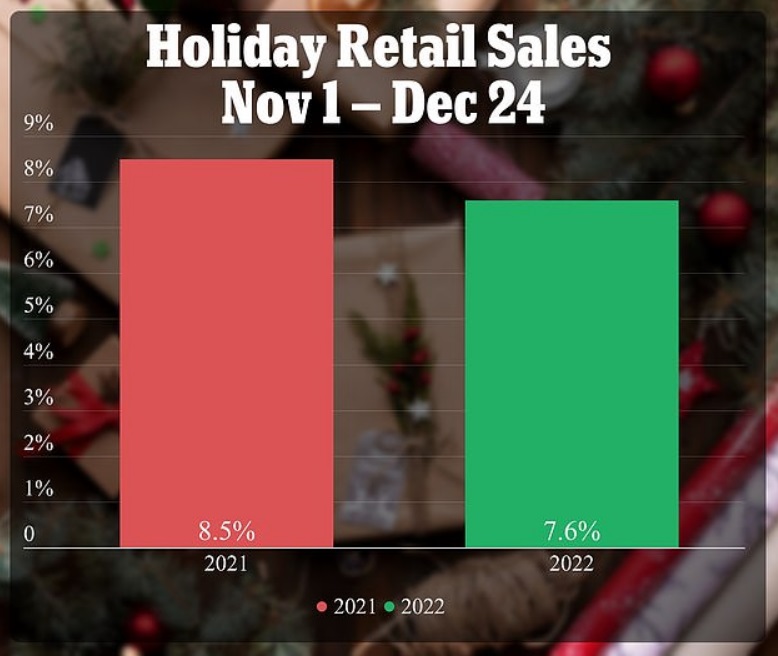According to Mastercard SpendingPulseTM, US retail sales excluding automotive increased 7.6% year-over-year this holiday season, running from November 1 through December 24.
Mastercard SpendingPulse measures in-store and online retail sales across all forms of payment and is not adjusted for inflation. However, this year’s holiday retail sales growth is less than the 8.5% increase last year as decades-high inflation, rising interest rates, and the threat of a recession turned consumers cautious. See this in the chart below and learn more here and here.
Mastercard SpendingPulse reports on national retail sales across all payment types in select markets around the world. The findings are based on aggregate sales activity in the Mastercard payments network, coupled with survey-based estimates for certain other payment forms, such as cash and check.
See a further breakdown of Mastercard’s SpendingPulse Christmas 2022 report in the table below.
| Mastercard SpendingPulse™ U.S. Retail Sales November 1 – December 24 |
| 2022 vs. 2021 | |
| Total retail (ex. auto) | 7.6% |
| In-store | 6.8% |
| E-commerce sales | 10.6% |
| Apparel | 4.4% |
| Department Stores | 1.0% |
| Electronics | -5.3% |
| Jewelry | -5.4% |
| Restaurants | 15.1% |
Other key Christmas 2022 sales figures from the Mastercard SpendingPulse report include the following.
- E-commerce shoppers ‘add to cart’: Online sales grew 10.6% compared to the same period last year, the preliminary insights show. This holiday season, e-commerce made up 21.6% of total retail sales, up from 20.9% in 2021 and 20.6% in 2020. The channel continues to experience elevated growth as consumers prioritize convenience and the availability of discounts.
- Weekend shopping reigns supreme: Black Friday sustains its title as the top spending day of the 2022 holiday season, up +12% year-over-year, excluding automotive. This was followed closely by Saturdays in December.
- Ringing in the holidays in restaurants: Building on the ongoing demand for experiences, in-person dining continued to show strong momentum, with restaurants up 15.1% YOY. From gatherings with co-workers to dinners out with friends and family, the festive season brought consumers out for the holidays.
What may not be said about this report is that retailers, including Amazon.com Inc and Walmart in the US, offered large discounts during the holiday season to get rid of excess stock and bring back inventories to normal levels. Hence, margins on these sales may not show up on the bottom line. One can see in the charts below that these two big retailers’ stocks are not responding to any 2022 Christmas sales success.

So were Christmas sales in 2022 a dud? It certainly was not a crash, but it mirrored many predictions – see here. Given that margin profits were not impressive and the sales increases seen merely kept up with inflation, one could say they were flat at best. With a potential recession looming in 2023, it may be a sign of things to come.
See more Chart of the Day posts.
By Tom Williams
















































